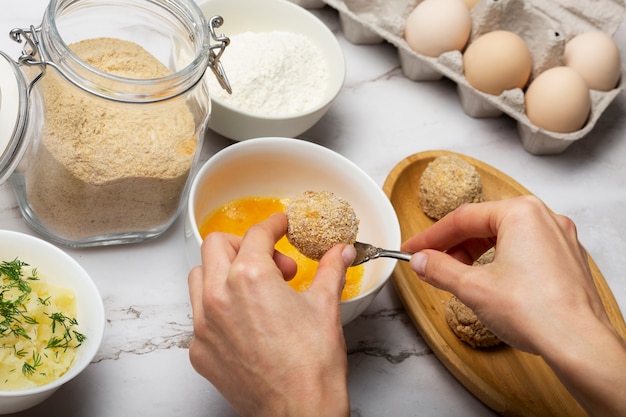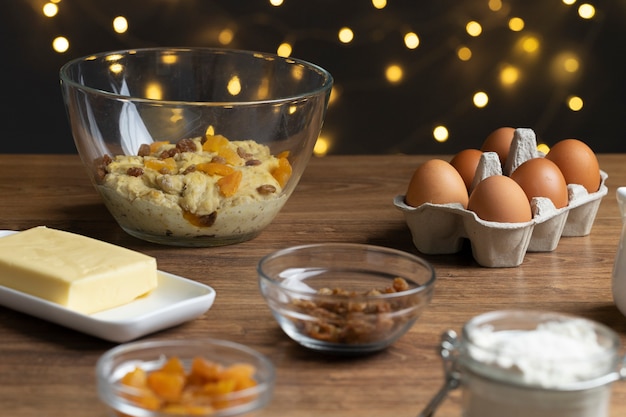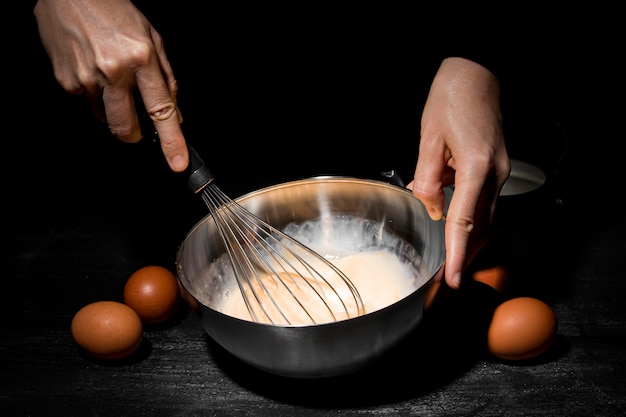It's a classic dilemma: you crave a delicious boiled egg, maybe for a quick breakfast or a tasty salad, but the end result is a rubbery yolk or a runny mess. Getting that perfect balance of a firm white and a creamy, runny yolk can feel like a culinary mystery. But fear not, dear reader, because today I'm sharing my tried-and-true guide to mastering the art of boiling the perfect egg.
Now, I've been a bit of an egg enthusiast for as long as I can remember. I have a soft spot for a good boiled egg, and I've spent years experimenting to find the perfect technique. I've learned from my mistakes, of course, and I've had my fair share of overcooked yolks and watery whites. But through those culinary mishaps, I've discovered a few key factors that make all the difference. I'm ready to share those secrets with you, my friends, so let's dive into this egg-cellent adventure!
Part 1: The Basics of boiling eggs

Boiling eggs is a simple concept, but there's actually a bit of science behind it. The key is understanding how heat affects the egg's protein. As the egg heats up, the proteins in both the white and the yolk start to solidify. The white, being mostly water and protein, sets quickly and turns opaque. The yolk, with its higher fat content, takes a bit longer to solidify.
Imagine the egg white as a delicate structure made up of long protein strands. As heat is applied, those strands unwind and tangle together, forming a firmer gel. The yolk's higher fat content makes it more resistant to heat, and its proteins take a bit longer to set. This is why the yolk remains runny for a longer time during the boiling process.
Understanding the Science Behind the Perfect Texture
The longer you cook the egg, the firmer the white and the yolk become. This is because the heat continues to unravel and tangle the proteins, making the egg firmer. So, the secret to getting that perfect runny yolk lies in controlling the cooking time.
Think of it like this: you want to cook the egg just long enough for the white to set, but not so long that the yolk solidifies. It's a delicate balance, but once you understand the science, it becomes a lot easier to achieve that perfect texture.
choosing the right eggs
You might think any old egg will do, but the truth is, the quality of your eggs can affect the final result. Opt for fresh eggs, as they tend to have a firmer white and a more vibrant yolk. You can even check the "best-by" date on the carton to make sure you're not using stale eggs.
Have you ever noticed that the whites of older eggs tend to be more watery? That's because the egg white naturally loses moisture over time. Fresh eggs, on the other hand, will have a thicker, more resilient white that holds its shape better during cooking.
I personally prefer free-range eggs for their richer flavour and slightly larger yolks. The yolks of free-range eggs are often a deeper orange colour, and they tend to have a richer flavour because the hens have a more varied diet. But ultimately, the choice is yours!
The Tools You'll Need
You don't need a fancy kitchen gadget to boil the perfect egg. You just need a few basic tools:
- A medium-sized saucepan - Make sure it's big enough to comfortably hold the eggs without crowding them.
- Cold water - The starting temperature of the water is crucial for even cooking.
- A slotted spoon or spider strainer - This will make it easier to carefully lower the eggs into the water and then remove them at the end.
- A bowl filled with ice water (optional but highly recommended!) - The ice bath is key to stopping the cooking process and preventing the yolk from overcooking.
Part 2: The Different Egg Cook Times

The key to mastering boiled eggs is understanding the different cook times and what they result in. Each cooking time produces a different texture, so it's important to know what you're aiming for.
Soft Boiled:
A soft-boiled egg is perfect for those who love a runny yolk. The white is firm, but the yolk is still liquid and creamy. It's a classic for dipping soldiers or spreading on toast, and it makes a delicious addition to salads.
To achieve a soft-boiled egg, cook the egg for 3-4 minutes. You'll want the yolk to be just slightly set around the edges, but the center should still be completely liquid.
Medium Boiled:
A medium-boiled egg offers a balance between a firm white and a slightly runny yolk. It's a versatile option for sandwiches, salads, and even as a snack. The yolk will be partially set but still have a bit of a creamy texture.
For a medium-boiled egg, cook the egg for 5-7 minutes. The yolk should be firm around the edges, but the center will still have a slight jiggle.
Hard Boiled:
A hard-boiled egg is great for those who prefer a firm yolk. The white is completely set, and the yolk is solid. It's perfect for deviled eggs, egg salad, or any recipe where you want a firm, easily chopped egg.
To achieve a hard-boiled egg, cook the egg for 8-10 minutes. The yolk will be completely solid and hold its shape.
Part 3: The Step-by-Step Guide

Now that you understand the basics, let's dive into the step-by-step process of boiling the perfect egg. Follow these simple steps, and you'll be on your way to achieving egg-cellent results!
1. Start with Cold Water:
This is crucial! Don't be tempted to add your eggs to boiling water. Starting with cold water ensures the egg cooks evenly and prevents the yolk from becoming rubbery. Why is this so important? Imagine the egg as a delicate little creature. If you plunge it into boiling water, the outer layers of the egg will cook too quickly, leaving the center raw. Starting with cold water allows the heat to penetrate the egg more gradually, resulting in a more evenly cooked product.
2. Gently Lower the Eggs:
Use a spoon or a spider strainer to carefully place the eggs in the saucepan. Avoid cracking them against the sides of the pan. A cracked egg won't necessarily ruin your cooking experience, but it can cause the white to leak out during the boiling process, and it can be more challenging to peel. Take your time and be gentle!
3. Bring to a Boil:
Turn the heat to medium-high and bring the water to a full boil. You'll know it's ready when you see large bubbles rising to the surface. While the water is heating up, it's a good time to set your timer for the desired cooking time. Remember, we're aiming for precise cooking times to achieve the perfect texture.
4. Cook for the Desired Time:
Once the water is boiling, use a timer to cook the eggs for the desired time depending on your preference.
Soft Boiled: 3-4 minutesMedium Boiled: 5-7 minutesHard Boiled: 8-10 minutes
5. Immediately Stop the Cooking:
Once the cooking time is up, immediately drain the hot water and transfer the eggs to a bowl of ice water. This is where the magic happens! The ice bath cools the eggs down quickly, stopping the cooking process and preventing the yolk from overcooking. This also makes the eggs easier to peel.
6. Enjoy!
Carefully peel the eggs, and enjoy them with your favorite toppings or side dishes.
Part 4: Tips and Tricks for Perfectly Boiled Eggs
Now that you've mastered the basic technique, let's delve into a few helpful tips and tricks to enhance your egg-boiling experience.
1. Don't Overcook:
The most common mistake people make is overcooking their eggs. This is why keeping a close eye on the cooking time is crucial. Overcooked eggs will have a rubbery yolk and a tough white, and it can be difficult to peel the shell.
2. The Ice Bath:
I can't stress enough how important the ice bath is. It's the key to stopping the cooking process and preventing the yolk from becoming green or rubbery. The cold water shocks the eggs, stopping the cooking process immediately and ensuring a perfectly cooked yolk.
3. Add Salt to the Water:
Adding salt to the water helps the eggs cook more evenly and prevents cracking. The salt helps to raise the boiling point of the water, ensuring that the eggs are cooked more consistently throughout.
4. Add Vinegar to the Water:
A splash of vinegar helps to prevent the egg whites from spilling out if the egg cracks during the cooking process. The vinegar helps to solidify the egg white, making it less likely to leak out. It also makes the peeling process easier.
Part 5: Dealing with Cracked Eggs
It happens to the best of us! Sometimes, an egg cracks while boiling. Don't fret; there are ways to salvage the situation.
1. Add Vinegar:
If the crack is small, adding a splash of vinegar to the water can help to solidify the white and prevent it from spilling out. The vinegar acts as a coagulant, helping to seal the crack and prevent the white from leaking out. This technique works best for small cracks; if the crack is significant, it's best to remove the egg from the boiling water.
2. Don't Overcook:
If the egg cracks, be extra careful not to overcook it. Overcooking will only make the situation worse, as the white will become rubbery and the yolk will become hard. It's best to remove the cracked egg from the boiling water as soon as possible to prevent overcooking.
3. Peel with Care:
When peeling a cracked egg, be extra gentle to avoid the white from breaking apart. Start by gently tapping the shell all around, then carefully peel under running water. If the shell is stubborn, use a spoon to help loosen it from the white.
Part 6: Peeling the Perfect Egg
peeling boiled eggs can be a bit of an art form, but with a few tips, you can avoid those frustrating bits of stuck-on shell.
1. The Ice Bath Again:
The ice bath is essential for easier peeling. It cools the egg down quickly, making the shell easier to remove. The cold water helps to contract the egg white, making it easier to separate from the shell.
2. Tap the Egg:
Tap the egg gently on a hard surface to crack the shell all around. This helps the shell to release from the white. A good trick is to tap the egg on a countertop or the bottom of a saucepan. Just be careful not to crack it too much, or you might end up with a broken egg.
3. Peel under Running Water:
Holding the egg under cold running water while peeling can help to loosen the shell and make the peeling process smoother. The running water helps to wash away any bits of shell that have already come off, and it also helps to lubricate the shell, making it easier to peel.
4. Use a Spoon:
If the shell is still stubborn, use a spoon to gently pry it away from the white. Start by gently scraping the shell around the edge of the egg, then work your way down, peeling the shell off in sections. Be careful not to press too hard, or you could end up with a cracked or broken egg.
Part 7: Using Your Boiled Eggs
So, now that you've mastered the art of boiling the perfect egg, what can you do with it? The possibilities are endless! Boiled eggs are a versatile ingredient that can be enjoyed in countless ways. Here are a few ideas to get you started:
Breakfast:
Boiled eggs are a classic breakfast staple. Enjoy them with toast, avocado, or a side of fruit. For a simple and satisfying breakfast, try a soft-boiled egg with soldiers, or top your toast with a slice of hard-boiled egg and a sprinkle of salt and pepper.
Salads:
Add boiled eggs to salads for a boost of protein and flavour. Chopped hard-boiled eggs are a classic addition to salads, adding a bit of texture and protein. For a more decadent salad, try topping a green salad with a soft-boiled egg, and drizzle with a balsamic vinaigrette.
Sandwiches:
Slice your boiled eggs and add them to sandwiches for a tasty and protein-packed meal. Hard-boiled eggs are perfect for egg salad sandwiches, and soft-boiled eggs make a delicious addition to breakfast sandwiches. Get creative with your fillings, and enjoy your homemade sandwich masterpiece.
Deviled Eggs:
Deviled eggs are a party favourite! You can get creative with your filling, using mayonnaise, mustard, chopped pickles, and more. For a classic deviled egg recipe, simply mash the yolk with mayonnaise, mustard, and a pinch of salt and pepper. You can also add chopped pickles, onions, or paprika for extra flavour.
Egg Salad:
Egg salad is a classic sandwich filling. It's simple to make and can be enjoyed on bread or crackers. For a basic egg salad, simply mash hard-boiled eggs with mayonnaise, mustard, and a pinch of salt and pepper. You can also add chopped celery, onion, or chives for extra flavour and texture.
Part 8: FAQ
I've covered a lot of ground in this guide, so you might have a few questions about boiling eggs. Here are some frequently asked questions and their answers:
1. Why do my boiled eggs have a green ring around the yolk?
The green ring around the yolk is caused by a chemical reaction between the iron in the yolk and the sulfur in the white. This happens when the egg is overcooked or when it's boiled for too long. To prevent the green ring, ensure you don't overcook the egg and use the ice bath to stop the cooking process promptly.
2. How long can I store boiled eggs in the refrigerator?
Boiled eggs can be stored in the refrigerator for up to one week. Keep them submerged in cold water to keep them fresh. The cold water helps to prevent the eggs from drying out and keeps them moist.
3. Can I use old eggs to boil?
While old eggs are still safe to eat, they may not be ideal for boiling. The whites of older eggs tend to be thinner and can become rubbery when cooked. It's best to use fresh eggs for the best results. If you do use older eggs, try boiling them for a slightly shorter time to prevent the whites from becoming too rubbery.
4. What if my eggs crack while boiling?
If an egg cracks while boiling, add a splash of vinegar to the water. The vinegar will help to solidify the white and prevent it from spilling out. If the crack is large, it's best to remove the egg from the boiling water to prevent the white from leaking out.
5. Why is my egg white rubbery?
Overcooking is the most common reason for a rubbery egg white. To avoid this, stick to the recommended cooking times and use the ice bath to stop the cooking process quickly. The ice bath helps to prevent the egg white from overcooking and becoming rubbery.
Now, you're armed with the knowledge and skills to become a boiled egg master! I hope this guide has helped you to understand the science, the technique, and the tips and tricks for perfecting your boiled eggs. So, go forth, my friends, and cook those perfect eggs!
Everyone is watching

How to Cook Frozen Lobster Tails Perfectly: A Step-by-Step Guide
RecipesLobster. Just the word conjures up images of lavish meals, special occasions, and a taste of luxury. But let's...

Pigs in a Blanket Cooking Time: How Long to Bake for Perfect Results
RecipesAh, pigs in a blanket. Just the name conjures up images of those delightful little parcels of crispy pastry en...

Pork Fillet Cooking Time: How Long to Cook It Perfectly
RecipesPork fillet, or tenderloin as it's sometimes called, is a real favourite in our house. It's so versatile, and...

The Ultimate Guide to Tender, Juicy Pulled Pork
RecipesRight, let's talk pulled pork. It's one of those dishes that just screams "comfort food," doesn't it? I mean...

The Ultimate Guide to Cooking Sweet Potatoes: From Roasting to Mashing
RecipesSweet potatoes. Just the name conjures up images of warm, comforting dishes, bursts of vibrant color, and a to...
